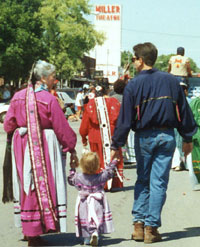
Three generations of Whitebread family
descendants celebrate their Caddo heritage during a
parade in Andarko, Oklahoma. Photograph courtesy Donna
Spaulding Smith.
Click images to enlarge
|

Julia Edge and her parents, 1908.
Julia was one of the last generations born and raised
speaking Caddo. In the 1970s, historian and Caddo tribal
member, Cecil Carter, spent many hours talking with
Julia Edge and carrying on the Caddo oral tradition.
Archives and Manuscript Division, Oklahoma Historical
Society.
|

Drum Dance underway at the dance
ground at the Caddo Tribal Center. Photograph by Dayna
Bowker Lee, folklorist and anthropologist at Northwestern
State University in Natchitoches, Louisiana. Lee has
done ethnohistoric research on the Caddo tribe and she
often attends tribal dances to document modern Caddo
traditions.
|
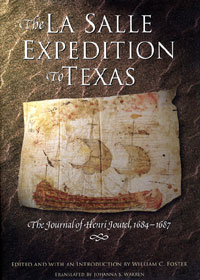
Henri Joutel's journal provides an
eyewitness account of his 1687 journey through the Caddo
Homeland. Historian William Foster's editorial
notes help put Joutel's observations into meaningful
context. Published by the Texas State Historical Association.
|

This study by famed historian Herbert
Eugene Bolton was not published until 1987, at least
50 years after it was written. Although belated, it
is still an important compilation of early Spanish accounts
concerning the Hasinai Caddo. Published by the University
of Oklahoma Press.
|
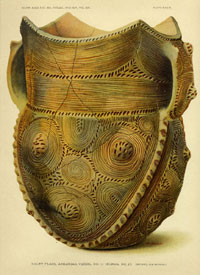
Color plate of late Caddo pottery
vessel excavated by C.B. Moore in 1911 from the Haley
site along the Red River in southwestern Arkansas. Moore
was the first archeologist to systematically explore
portions of the Caddo Homeland.
|
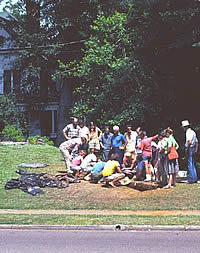
1979 dig during an archeological
field school held by Stephen F. Austin University
in Nacogdoches, Texas under the direction of professor
James Corbin. The Reavley House Mound is a surviving
remnant of a 700-year-old Caddo ritual center. Photo
courtesy Dee Ann Story.
|

Alex Krieger is regarded as the first
real scholar to take an interest in Caddo archeology.
Photograph from TARL archives.
|
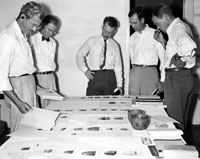
1950 Caddo Conference participants
comparing and discussing pottery types. From left to
right, Alex Krieger, Clarence Webb (conference host),
John Cotter, Walter Hagg, and Lynn Howard. Photograph
by Robert L. Stephenson, TARL archives, Louisiana G-1.
|
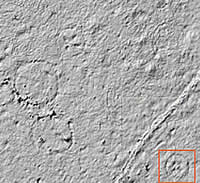
Section of geophysical map showing
a small area at the George C. Davis site in which at
least three structural patterns are readily discernable.
The orange square highlights a circular pattern of a
building about 11 meters (36 feet) across with four
internal roof supports and a hearth in the middle. The
angled line running through the image is one of the
signature of one of the interpretive footpaths at Caddoan
Mounds State Historic Park. (The right-angled glitches
are minor data/processing gaps.) Courtesy Darrel Creel
and Dale Hudler, TARL.
|
|
Oral history, written history, linguistics,
ethnography, ethnohistory, bioanthropology, and archeology
each provide critical clues about the long march of Caddo
history. Here we briefly mention some of the major sources
of knowledge and highlight the strengths and limitations of
each. Sophisticated understandings of the complex and lengthy
history of Caddo peoples can only come through combining sources
of information and checking one against the other.
Oral tradition remains important to Caddo
people, but the most essential context for maintaining that
tradition—Caddo language—is gravely imperiled. Anthropologists
and linguists have shown that languages and cultures are so
intimately linked that one can hardly exist without the other.
Languages become extinct when children are no longer raised
speaking the mother tongue, and that has been the case with
the Caddo for at least a generation. There are still about
30 fluent Caddo speakers, but none is young. A small nonprofit
foundation, Kiwat
Hasinay, is dedicated to preserving the Caddo language
and encouraging its revival. One of the foundation's projects
has been an effort to create a community-based program to
teach the language to Caddo children. Through such efforts
and through shared stories, song, and dance, Caddo peoples
will continue to pass on important memories of the Caddo past
and present. In doing so they are creating a new living tradition,
a celebration of Caddo history and identity.
Caddo oral traditions have entered into the
written record in various ways. Some are known through the
records of linguists and ethnographers who have interviewed
Caddo elders and translated their stories. The work of linguists,
those who study the nature and structure of language, is discussed
in the "Caddoan
Languages and Peoples" section. Linguistics is sometimes
considered a subfield of anthropology and sometimes a separate
field of its own. Unfortunately, only a single linguist, Wallace
Chafe, has intensively studied the Caddo language in modern
times and the major results of his work have not been published.
Ethnographers are anthropologists who
study and describe other cultures by visiting, observing,
and asking questions. The best ethnographers are "participant
observers" who spend extended periods of time living
in the community they are studying and learning the native
language. Unfortunately, by the time ethnographers began visiting
the Caddo in the early 1900s, Caddo society had been radically
altered by historic events. Still, ethnographers and folklorists
such as George Dorsey (working in 1903-1904), John
Swanton (ca. 1911), and Elsie Clews Parsons (1930s)
interviewed Caddo elders who were raised speaking Caddo. Modern
historians such as Cecile Elkins Carter have
carried on this tradition by interviewing Caddo elders and
recording their recollections and stories.
Ethnohistorians are anthropologists who
use documentary evidence to glean ethnographic observations
and understandings of aboriginal societies. Their work overlaps
with that of traditional historians, but stands apart
because ethnohistorians are more concerned with reconstructing
the nature of aboriginal societies rather than the sequence
of events and the impact of individuals. Historians and ethnohistorians
are both limited by the surviving documents; there are relatively
few early accounts with substantive detail about Caddo life
and Caddo peoples. Still, new documents and new versions of
known documents are still being discovered from time to time
in archives. New insight also can be gained from improved
translations of known documents.
The work of John Swanton, a student of
the famed ethnographer Franz Boas, is widely regarded as the
most important ethnohistoric study of the Caddo. His 1942
book, Source Material on the History and Ethnology of the
Caddo Indians, combines his own observations with cautious
interpretations of those made by various explorers, missionaries,
soldiers, and more. The eyewitness accounts of early Spanish
and French visitors to the Caddo Homeland are primary sources
of knowledge. Such observations are also often highly biased
and selective, reflecting the prejudices, motives, and abilities
of the observer as much or more than the character of the
observed.
Two early chroniclers of Caddo life stand out.
Henrí Joutel, a young Frenchman who survived
La Salle's disastrous colony on the Texas coast, spent four
months traveling through the Caddo Homeland in the spring
and summer of 1687. His remarkable journey included visits
to Hasinai villages in the Neches-Angelina drainages, the
Nasoni village (see "Upper
Nasoni" exhibit) and others linked to the Cadohadacho
along the Red River, and Cahino villages further east on the
Ouachita. Joutel's journal contains invaluable observations
about the Caddo world as seen by an intelligent observer who
had no real ulterior motive other than to survive.
Only a few years later, the Spanish priest,
Francisco de Jesús Maria Casañas, spent
15 months (1690-1691) living among the Nabedache (the westernmost
Nasinai group) on the Neches River. He was part of the Spanish
expedition that founded the first mission to the Caddo, Mission
San Franciso de las Tejas in present day Houston County, Texas.
Fray Casañas was a devoted priest motivated by the
desire to save heathen souls, but he was also a shrewd observer
who stayed long enough in one place to get a real sense of
the annual cycle of Caddo life. His Relacíon
was written while in residence at the mission.
The primary documents written by Joutel, Casañas,
and many others did not become well known until the 20th century
when professional historians began translating and studying
these sources. Famed historian Herbert Eugene Bolton
became interested in the Hasinai Caddo in 1906 and studied
many of the primary documents on and off over the next several
decades. Regrettably, his manuscript on the Hasinai was not
published until 1987, long after his death in 1953 and at
least 50 years after it was written. Apparently he was never
satisfied with what amounted to an ethnohistorical study.
As a consequence, Bolton's work did not have the impact it
would have had, had it been published in a timely fashion.
Bolton's posthumous book, The Hasinais: Southern Caddoans
as Seen by the Earliest Europeans, covers much of the
same material presented in a similarly titled 1954 study by
William J. Griffith, The Hasinai Indians of East
Texas as Seen by Europeans, 1687-1772. Late in life, Bolton
encouraged Griffith's work, apparently believing that his
own would never be published.
In the last few decades a number of historians
and archeologists have published historical accounts of Caddo
peoples. These include traditional historians such as Todd
Smith and David LeVere and historically minded
archeologists such as Kathleen Gilmore, George Sabo,
and Timothy K. Perttula, as well as several historians
who are also members of the Caddo tribe. Hasinai: A Traditional
History of the Caddo Confederacy by Vynola Newkumet
and historian Howard Meredith was the first such study
(1988). Cecile Elkins Carter's 1995 book Caddo Indians:
Where We Come From synthesizes history, oral tradition,
and archeology from a Caddo perspective.
Bioanthropologists (also known as biological
or physical anthropologists) study the skeletal remains from
archeological excavations at Caddo sites. This research domain
has yielded extremely valuable data available through no other
means. By studying human bones, bioanthropologists can look
at the health of individuals and their diet, age, sex, incidence
of disease, and evidence of trauma, such as broken bones.
Some information comes from careful scientific examination
and measurement, but some studies require the destruction
of small samples of bone. Such samples can, for example, be
used for radiocarbon dating and for determining carbon and
nitrogen isotope values, which reflect diet. By comparing
samples from individuals dating to different time periods
and from different areas of the Caddo Homeland, one can examine
broad patterns of health and nutrition. While such studies
have been done very successfully in some parts of the country,
the human remains in the Caddo Homeland are often very poorly
preserved or completely destroyed by acidic soils.
From a scientific perspective, studies of human
remains can be very informative. But many Caddos and other
Native Americans feel very strongly that any disturbance of
their ancestors' graves is wrong. Some view archeological
excavations of graves as grave robbing and oppose all forms
of bioanthropological analysis. Others see the value of some
studies, particularly the non-destructive ones, when graves
lay unalterably in the path of "progress." Still
others do not object to destructive testing when it is being
done for a solid scientific purpose that promises to shed
light on Caddo history. See "Graves
of Caddo Ancestors" for more discussion of this controversial
topic.
Archeologists study early Caddo
history by documenting, mapping, and excavating Caddo sites
and examining "material culture," meaning the tangible
physical remains such as pottery, stone tools, animal bones,
and so on found at the sites. Since archeologists have been
investigating sites in the Caddo Homeland for almost a century,
a thorough review of the history of investigation would be
lengthy. Here we will outline only the major developments.
The first systematic archeological exploration
of the region began around 1908 through the efforts of Clarence
B. Moore of the Philadelphia Academy of Science. Moore's
elaborately illustrated reports of his work at sites along
the Red and Ouachita rivers are valuable sources of information.
In fact, his observations are all that will ever be known
of several mound sites that were subsequently destroyed by
the meandering Red River. Moore's work in the Caddo area was
followed by the 1917-1920 explorations in the southern Ouachita
Mountains by Mark R. Harrington on behalf of the Heye
Foundation of New York.
By 1920s, it was thought that the mound sites
along the Red River in Arkansas and Texas were probably associated
with the Cadohadacho and that sites in the Neches-Angelina
drainages in east Texas were linked to the Hasinai. In 1930,
with modest funding from the Smithsonian Institution, the
University of Texas began undertaking major excavations at
a number of Caddo sites in east Texas under the supervision
of James Pearce and his field director, A. T. Jackson.
After the mid-1930s, funding and manpower from the WPA (Works
Progress Administration) allowed the University of Texas to
expand its work in east Texas.
Like Moore, the University of Texas archeologists
chose prominent mound sites like the Hatchel Mound near Texarkana
(see Upper
Nasoni exhibit) and the Sanders site north of Paris, Texas,
and locales where prehistoric cemeteries were known to exist.
Graves were sought out because they often contained whole
pots and other interesting objects. Similar excavations were
undertaken at Caddo sites in Oklahoma and Arkansas in the
1930s under the WPA. Such projects resulted in a great many
whole and fragmentary pottery vessels and many other artifacts,
but little real appreciation of Caddo history and few substantive
publications. This was to change in the 1940s as the result
of the efforts of the first real scholar to take an interest
in Caddo archeology, Alex D. Krieger.
Krieger was placed in charge of the WPA lab
at the University of Texas in Austin in the late 1930s and
soon began systematic comparisons among collections from different
sites in the Caddo area. During World War II, he wrote the
first synthesis of Caddo history based on his comparative
studies as part of his larger 1946 study Culture Complexes
and Chronology in Northern Texas. He continued this work
during his analysis of the artifacts from the George C. Davis
site. The Davis site near Nacogdoches, Texas, had been excavated
in 1939-1941 by the WPA under the direction of a skilled and
meticulous field archeologist, Perry Newell. Newell
died just after World War II, leaving Krieger to finish their
now-famous 1949 report, The George C. Davis Site, Cherokee
County, Texas.
In these two studies, Krieger synthesized the
culture history of the "Caddoan" area, including
Spiro and the Arkansas Basin. He defined Early Caddoan (Gibson
aspect) and Late Caddoan (Fulton aspect) periods as well as
thirteen geographical clusters (foci) across the Caddoan area
that he thought represented closely related sites. Krieger
put quote marks around the term "Caddoan" because
he realized the area had a more diversity than implied by
the label. While many of Krieger's concepts were later refined
or discarded, his work brought national recognition of the
Caddo area and of its relationship to parallel developments
in the lower Mississippi Valley and elsewhere in the Eastern
Woodlands.
One of Krieger's most important collaborators
was Clarence H. Webb, a pediatrician from Shreveport,
Louisiana, who became a very influential Caddo archeologist.
Webb began investigating Caddo sites along the Red River in
northwestern Louisiana in 1935 and kept at it for the next
45 years. While Webb had no formal training in archeology,
his medical education, familiarity with the area, and aptitude
more than made up for it. Webb's energy, enthusiasm, and long-term
persistence were unmatched. Working on weekends and vacations,
Webb and his friends conducted excavations at numerous major
Caddo sites including Mounds Plantation, Gahagan, and Belcher.
He reported the results in conference presentations, journal
articles and monographs, including one entitled The Belcher
Mound: A Stratified Caddoan Site in Caddo Parish, Louisiana
that was published in 1959 as a Memoir of the Society for
American Archaeology. Through such efforts he succeeded in
demonstrating the antiquity of Caddo and pre-Caddo settlement
in the region. He also pioneered the use of the direct historical
method in the Caddo area, tracing Caddo patterns back in time
from historical records into prehistory.
Webb was instrumental in starting a very useful
scholarly tradition, the Caddoan (or Caddo) Conference.
The first conferences in the late 1930s were informal gatherings
at Webb's house attended by only the handful of researchers
who knew or cared about Caddo archeology (Krieger and Newell
were among them). As time went on the Caddo Conference became
a more regular, and then annual, event attended by dozens
and sometimes hundreds of researchers, students, and enthusiasts.
These conferences were and are essential devices for breaking
down the state-line barriers and uniting archeologists in
Arkansas, Louisiana, Oklahoma, and Texas. By the 1970s Caddo
tribal members began participating in the conference, resulting
in improved communication between the archeologists and the
Indians whose ancestors they studied.
In recent decades there have been dozens of
major investigations at Caddo sites and hundreds of smaller
ones. In 1960s and 1970s reservoir salvage archeology provided
the impetus and opportunity to undertake research at a number
of important locales within the Caddo Homeland in Oklahoma,
Texas, and Arkansas. Since the late 1970s, federal and state
cultural resource laws have led to much more archeological
work in the region. In fact, contract or CRM (cultural
resource management) archeology accounts for most of the research
done at Caddo sites over the last 25 years. Although many
CRM projects are small and the results usually reported in
technical reports of limited distribution, excellent research
has been accomplished on smaller sites that probably would
not have attracted other researchers. CRM projects have also
provided the first systematic surveys in the Caddo Homeland,
recording many small habitation sites in places archeologists
had previously ignored.
Despite the increase in CRM-related investigation,
the Caddo Homeland has seen less concentrated research than
many other areas of the Eastern Woodlands. One of the main
reasons for this inequity is that major public and private
universities in all four states are situated outside the Caddo
area. As a direct consequence, the region long lacked resident
professional archeologists. Fortunately, two changes have
occurred. One has been the hiring of archeologists as teachers
at several smaller universities in the area. In Texas, James
Corbin at Stephen F. Austin State University in Nacogdoches
has been active in Caddo archeology as has Hiram Gregory
at Northwestern State University in Natchitoches, Louisiana.
The other welcome change has been the establishment of regional
"station" archeologists in Arkansas and Louisiana
in the 1970s and 1980s, respectively. This has meant that
professional archeologists are living and working in the Caddo
Homeland year round. Archeologists Ann Early (now Arkansas
State Archeologist), George Sabo, and Frank Schambach
in Arkansas, as well as Jeff Girard and George Avery
in Louisiana have made major contributions. Typically,
the station archeologists also teach at small universities
and colleges in the region.
In Texas and Arkansas and, to a lesser extent,
Oklahoma and Louisiana, state and regional archeological societies
and associations have held field schools and conducted research
at numerous Caddo sites. Such organizations are made up of
avocational (amateur) and professional archeologists. In Arkansas
and Louisiana, avocational archeologists usually work with
the regional and station archeologists. In Texas and Oklahoma,
avocational archeologists sometimes work with the state historic
preservation offices and sometimes work on their own.
Today archeologists are asking new questions
and applying new technology to learn more about Caddo ancestors.
Darrell Creel, director of TARL, and Samuel Wilson,
professor of anthropology at UT Austin, are currently directing
new investigations at the George C. Davis site. Their goal
is to create a detailed map of the Early Caddo settlement
using state-of-the-art geophysical survey equipment. This
equipment allows archeologists to detect subtle magnetic variations
created 700-1200 years ago by Caddo builders. The result,
as can be seen to the left, are nothing short of amazing.
The use of such non-destructive techniques holds great promise
for the future of Caddo archeology.
|
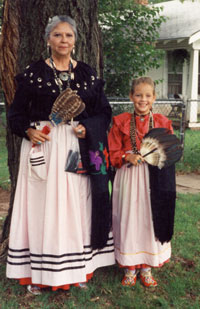
Donna Smith Spaulding and young Caddo
friend, LaDawna Supernaw, in traditional dance clothes.
Although the Caddo language is no longer spoken by Caddo
children, Caddo traditions and ceremonial regalia are
passed down from generation to generation. Photograph
courtesy Donna Smith Spaulding.
|
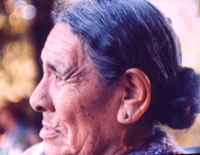
Portrait of Julia Edge as a Caddo
elder in the late 1970s. Photo by Cecile Carter.
|
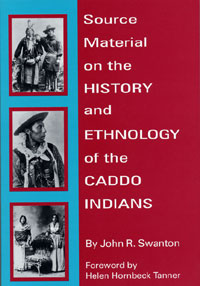
The 1996 edition of John Swanton's
classic Caddo source book originally published in 1942.
Published by the University of Oklahoma Press.
|
| |
|
There are normally eight or ten families in these
huts, which are very large; some are 60 feet in diameter…
These are round, in the shape of beehives, or rather
like large haystacks … They are covered with grass
from the ground to the top. They make a fire in the
center, the smoke going out the top through the grass.
(Henri Joutel, describing the houses he saw among the
Hasinai groups in 1687.)
|
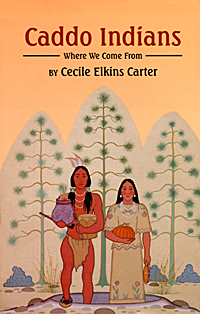 Cecile Elkins Carter's 1995 book
synthesizes history, oral tradition, and archeology
from a Caddo perspective. Carter also wrote the "Caddo
Voices" section of the Tejas online exhibit. Now
available in paperback from the University of Oklahoma
Press.
Cecile Elkins Carter's 1995 book
synthesizes history, oral tradition, and archeology
from a Caddo perspective. Carter also wrote the "Caddo
Voices" section of the Tejas online exhibit. Now
available in paperback from the University of Oklahoma
Press. |
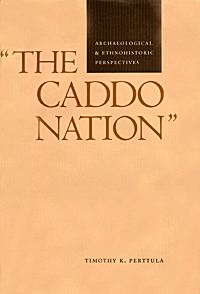 Timothy Pertula's 1992 book summarizes
archeological and ethnohistorical data on the period from
about A.D. 1520 to 1800. Now available in paperback from
the University of Texas Press.
Timothy Pertula's 1992 book summarizes
archeological and ethnohistorical data on the period from
about A.D. 1520 to 1800. Now available in paperback from
the University of Texas Press. |
| |
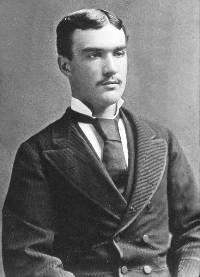 Clarence B. Moore as a young man
at Harvard College. Years later, under the sponsorship
of the Philadelphia Academy of Science, Moore undertook
the first systematic archeological exploration of Caddo
sites along the Red and Ouachita rivers. His observations
are all that will ever be known of several mound sites
that were subsequently destroyed by the meandering Red
River.
Clarence B. Moore as a young man
at Harvard College. Years later, under the sponsorship
of the Philadelphia Academy of Science, Moore undertook
the first systematic archeological exploration of Caddo
sites along the Red and Ouachita rivers. His observations
are all that will ever be known of several mound sites
that were subsequently destroyed by the meandering Red
River. |
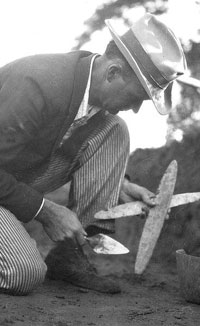
Rare photo of A. T. Jackson, a former
newspaper reporter who became James Pearce's chief field
archeologist. It was Jackson who directed most of the
excavations at Caddo sites in northeast Texas that the
University of Texas undertook in the 1930s. Jackson
is rarely seen in archival photos, in part because it
was he that usually took the photos. This photo was
taken in 1931 at the J. E. Galt farm in Franklin County.
TARL archives.
|
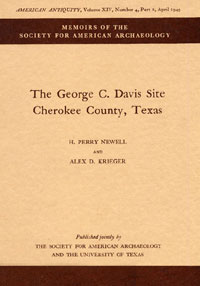
This 1949 report brought national
attention to the Caddo area. The Society for American
Archeology issued a new paperback edition in 2000 with
an introduction by Dee Ann Story.
|
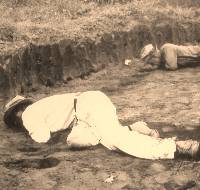
Workers clean out the postholes of
a large building at the A.C. Saunders site in 1935 under
the direction of A.T. Jackson of the University of Texas.
TARL archives.
|

Archeologists at work at the George
C. Davis site in Cherokee County, Texas, 1969. The complex
layers of earth are clearly visible in the walls of
Mound C. TARL Archives.
|

Workers from the University of Texas-WPA project uncovering
structural remains within the Hatchel Mound near Texarkana
in 1938. This archeological excavation was among the
largest ever undertaken at a Caddo site. Photograph
from TARL archives. |
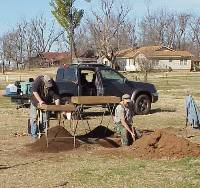
Test excavations in 2003 at the
Hatchel-Mitchell site under the direction of Tim Perttula.
The team is exploring the village area, instead of the
mound and graves targeted by the 1930s WPA work. Photo
by Mark Walters. |
|

